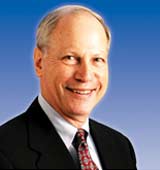|
Executive Interviews: Interview with Michael Beer on Change Management
June 2007
-
By Dr. Nagendra V Chowdary
 Michael Beer
Michael Beer
Cahners-Rabb Professor of Business Administration, Emeritus at the Harvard Business School, Chairman and co-founder of TruePoint a research based consultancy.

-
You have remarked in Cracking the
Code of Change, "Indeed, it is highly
unlikely that E would successfully
follow O because of the sense of
betrayal that would involve". Is it
therefore better to sequence the
change with Theory E first and Theory
O next? Why should it be so?
The ideal is to employ E and O
simultaneously and in a way that they
are integrated. By integration, I mean,
that E is carried out in a way that
develops commitment or at least does
not materially reduce it. Practically
speaking, E will almost always lead O
because, there are economic
imperatives the CEO must deal with
(loan covenants, short-term earning
|
|
pressures etc.)but in the best case, as
illustrated by the ASDA case, E and O
strategies are launched very early.
There are two reasons why E should
not generally follow O. First, if O has
been applied consistently over time,
the company is likely to have been
learning, adapting and changing
continuously and will not need E
strategies. Second, if E does follow O it
is likely to tear the high commitment
culture built with O. As the ASDA example (in 'Cracking
the Code of Change') shows very
correctly, the change agent (the CEO)
should be very clear about what he's
doing. Therefore, before embarking
upon this 'Balancing Act', what
precautions need to be taken to
achieve the desired results? Should
one of those prerequisites be a
guaranteed tenure for the CEO (like in
the case of GE for instance) so that he
could see the initiative through its
logical conclusion?
By definition, an integrated E and O
theory strategy for change will be
slower than a revolution of the kind
Jack Welch produced in the 1980s
(downsizing 150,000 employees or
more and selling businesses that were
not number 1 or 2). Therefore, CEOs
who embark on E and O
simultaneously will have to create
agreements with the board, creditors
and key stakeholders that will enable
them to have the time they need to
build an organization. Archie Norman
told shareholders not to expect
significant results for three years.
When Allan Leighton took over the
Royal Post at Tony Blaire's request
(after he had left ASDA) he set
conditions that gave him freedom to
act "Don't call me and don't interfere
with my change strategy and the
people I hire, regardless of what
happens and what you hear". He set
the boundaries for an effective change
effort and succeeded. Jack Welch also seemed to have
combined both Theory E and Theory
O. And in most of these cases, change
initiatives seem to be signature
statements for a legacy rather than
making them the DNA for an
organization. How should CEOs,
therefore, look at change initiatives
holistically so that change
management becomes a part of
organizational philosophy?
I don't think initiatives such as Six
Sigma and Workout were Jack Welch's
legacy. These were tools the means
to an end. Rather, his legacy is the
fundamental transformation from
bureaucracy to a high commitment
and performance organization with a
very different culture than existed in
1980 when he took charge. In Cracking the Code of Change you
have observed, "Making way for
opposite leadership styles was also an
essential ingredient to Norman's – and
ASDA's – success". Should this also be
I N T E R V I EW 7
looked at as a prerequisite for the
Balancing Act? Are you, therefore,
suggesting that when companies wish
to follow the Balancing Act, they must
have two CEOs? (one for 'Theory E'
and one for 'Theory O')? However,
what happens (and therefore, who
should resolve) when the going gets
tough between those two people
(leaders)?
Though it is possible for a single
individual to have the capacity,
personality and skills to balance and
integrate E and O, few are able to do
this. They need partners who
complement their perspective and
skills. Those partners (in most
successful change efforts there is a
very small group of 2 to 4) bring
different skills and perspective to the
change effort and can make up for the
CEO flat sides. However, these
members of the team are not CEOs.
The CEO has final authority. Norman
and Leighton were not both CEOs. But
Norman and Leighton and two other
members of the top team (not
mentioned in the article) comprised
what Norman told me was a small and
highly dedicated team that acted as
one. To do this, CEOs cannot have
hubris, must be willing to work in an
egalitarian manner with subordinates
and create the climate for a fact-based
dialogue. The CEO clearly has the
final say, but CEOs that rely too often
on their final say have not formed an
effective team and will not be told by
those on the team what they need to
hear.
1.
Change Management Case Studies
2. ICMR
Case Collection
3.
Case Study Volumes
|
